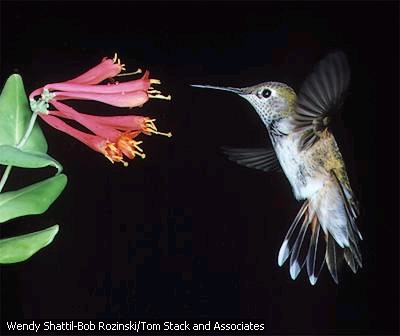 Hummingbirds:
Relative to their size, Hummingbirds have the largest flight muscles of
any bird; up to 30% of their total weight.
Hummingbirds:
Relative to their size, Hummingbirds have the largest flight muscles of
any bird; up to 30% of their total weight.
Their wings are anchored
to a specialized keel
shaped sternum
and formed in a way which allows them to rotate in a figure eight pattern,
one reason they beat their wings up to 78 times a second.
"As the wing sweeps toward
the front, the leading edge rotates forward for lift on the down stroke.
Then as the wing sweeps to the rear, the leading edge rotates back for
lift on the upstroke too.
"Other birds, with their
up and down flapping, get only lift on the down stroke. But the Hummingbird's
unusual flexibility enables it to hover, back away on the wing, even fly
nearly upside down. They can outmaneuver hawks and other birds a hundred
times their size, driving them off in the process.
"Hummingbirds get from Mexico
to Alaska and back, remembering the flower patches and feeders enroute.
"All that memory in a brain
case as big as Abe Lincoln's head on an American penny."
...Bill Calder, Rocky Mountain Biological Laboratory, Gothic, Colorado.
To keep itself alive a Hummingbird
must get 7 to 12 calories a day and that's the equivalent of a 180 pound
human scrounging
up 204,000 calories a day or about 171 pounds of hamburger. It must drink
twice its weight in nectar daily, finding as many as 1000 flowers with
nectar to drink.
A hummingbird breathes some
250 times a minute.
They have twice
as much heart as might be expected for a bird this size. In addition, they
have a much more dense concentration of red cells for storage of oxygen.
Unlike other birds, they
rotate their wings in a figure eight pattern. They are able to accommodate
this unusual pattern of wing motion due to the design of their exceptionally
flexible shoulder joints.
When a Hummingbird hovers,
its wings horizontally flap. Other birds wings flap up and down.
In flight its
wings angle frontwards. It knows how to do all that because it's designed
that way.
Hummingbirds' noses pick
up strange 'tag alongs'!
"When
they court, they shoot straight up 60 feet and back down in a power dive
giving off a metallic.trill
as urgent as
a bicycle bell."....Smithsonian,
September, 2000.
A Hummingbird's heart beats
some 1,200 times a minute in flight and its wings beat at a minimum of
2,280 revolutions per minute, some much higher.
The female.only.can
reduce her temperature by half.
In torpor
she can reduce her metabolism
2 to 3 times for every 10 degree drop in temperature.
How does she know to regurgitate
her food for her nestlings?
A Hummingbird's tongue is
anatomically.unorthodox.
Its tongue is either hinged to muscles that run back around the spinal
cord, or in others, the tongue is fringed along the outer edge and yet
in others, the tongue ends in two trough
like channels with which the bird draws up nectar, not by sucking but by
capillary
action as the tongue flicks in and out.
The hummingbird beats its
wings 80 times a second and can travel up to 30 miles per hour. Its wings
axially
rotate at 180 degrees
thanks to a supple
shoulder joint. They can cross 600 miles in 20 hours. It is properly designed
for its incredible flying abilities with a big keel
and breastbone and powerful flight muscles. Tapered
wings are attached to short arm bones with rigid
elbow and wrist joints. It can hover
with its body in a vertical position. Its wings move in a figure eight
pattern, a type of motion that provides lift without propulsion.
They grow about 5 inches
in length and weigh about 1/3 ounce (8.4 grams). They
migrate
in winter to equatorial countries. They take in nectar with a sucrose concentration
of 15-30% and avoid nectar with less than 12% sucrose. They know how to
do this as it is programmed into them exactly what to have an affinity
for.